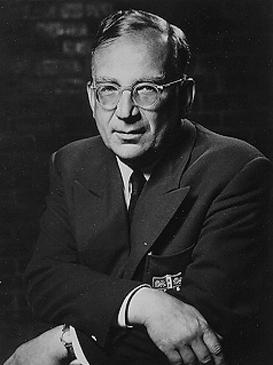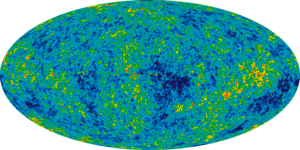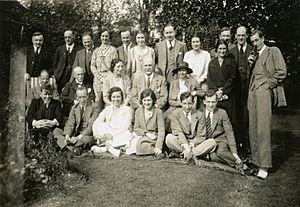George Gamow facts for kids
Quick facts for kids
George Gamow
|
|
|---|---|
 |
|
| Born |
Georgiy Antonovich Gamov
March 4, 1904 (O.S. February 20, 1904) |
| Died | August 19, 1968 (aged 64) Boulder, Colorado, United States
|
| Citizenship | Soviet Union United States |
| Alma mater | Leningrad State University |
| Known for |
|
| Spouse(s) | Rho (m. 1931, div. 1956) Barbara (m. 1958) |
| Children | 1 (Igor Gamow) |
| Awards | Kalinga Prize (1956) |
| Scientific career | |
| Fields | Physicist, science writer |
| Institutions |
|
| Doctoral advisor | Alexander Friedmann |
| Doctoral students |
|
| Signature | |
| Physical cosmology | ||||||||||||||
 |
||||||||||||||
| Universe · Big Bang Age of the universe Timeline of the Big Bang Ultimate fate of the universe
|
||||||||||||||
George Gamow (March 4, 1904 – August 19, 1968) was a brilliant physicist and science writer. He was born in the Russian Empire and later became an American citizen. Gamow was a true polymath, meaning he had knowledge in many different subjects.
He was one of the first to support and develop the Big Bang theory, which explains how our universe began. He also figured out how alpha decay happens through something called quantum tunneling. Gamow created the "liquid drop model" for the atomic nucleus and studied how stars form and how elements are made in the universe. He even worked on molecular genetics, which is about DNA.
Later in his life, Gamow loved teaching and writing popular science books. His books, like One Two Three... Infinity and the Mr Tompkins series, are still enjoyed by many people today.
Contents
Early Life and Studies
George Gamow was born in Odessa, which was part of the Russian Empire at the time. His parents were both teachers. His father taught Russian, and his mother taught geography and history. George learned several languages, including French, German, and later English.
He studied at the Institute of Physics and Mathematics in Odessa and then at the University of Leningrad. In Leningrad, he became friends with three other physics students: Lev Landau, Dmitri Ivanenko, and Matvey Bronshtein. They called themselves the "Three Musketeers" and often met to discuss new ideas in quantum mechanics.
After graduating, Gamow continued his studies in Göttingen, Germany. His research there helped him earn his doctorate. He then worked at the Niels Bohr Institute in Copenhagen, Denmark, and also with Ernest Rutherford in Cambridge, England. He kept studying the atomic nucleus and even proposed the "liquid drop" model for it. He also worked on how stars work.
In 1931, when he was only 28, Gamow became a member of the Soviet Academy of Sciences. This was a big achievement for someone so young! He helped design Europe's first cyclotron, a machine used to speed up particles.
Understanding Radioactive Decay
In the early 1900s, scientists knew that radioactive materials broke down at a steady rate. They also knew that these materials released energy in specific amounts. In 1928, Gamow figured out why alpha decay happens. He explained that particles can "tunnel through" the strong forces holding the nucleus together, even if they don't have enough energy to go over the "wall."
This idea, called quantum tunneling, was a big breakthrough. Gamow's work explained a rule that scientists had observed but couldn't explain: how the time it takes for a radioactive material to decay (its half-life) is related to the energy it releases. This concept is now known as the Gamow factor.
Moving to America
Life in the Soviet Union became difficult for scientists like Gamow. In 1931, he was not allowed to attend a science conference in Italy. That same year, he married Lyubov Vokhmintseva, a physicist he called "Rho."
Gamow and Rho tried to leave the Soviet Union several times. He even tried to kayak across the Black Sea to Turkey, and from Murmansk to Norway, but bad weather stopped them.
In 1933, Gamow finally got permission to attend a physics conference in Brussels. He insisted that his wife come with him. With help from famous scientists like Marie Curie, they managed to extend their stay and eventually moved to the United States in 1934.
Gamow became a professor at George Washington University (GWU) in 1934. He invited another physicist, Edward Teller, to join him there. Together, they developed an important rule for beta decay called the "Gamow–Teller selection rule." Gamow also started focusing on astrophysics and cosmology, which is the study of the universe.
In 1940, George Gamow became an American citizen. During World War II, he taught physics at GWU and advised the US Navy. He also studied how planets form in our Solar System.
The Big Bang Theory
George Gamow played a huge role in developing the "hot Big Bang" theory. This theory explains that the universe started from a very hot, dense state and has been expanding ever since. Gamow was the first to suggest that the early universe was filled with radiation, not just matter. Most of what we know about cosmology today is built on Gamow's ideas.
He used his model to explain how the different chemical elements were created in the early universe. He also calculated the size and mass of early galaxies using fundamental physics rules.
Gamow initially thought that all elements were made in the Big Bang. But later, he realized that heavier elements are mostly created inside stars and during supernovae (exploding stars). He worked with his student, Ralph Alpher, to solve equations that described how elements formed. Their work, along with Hans Bethe, became known as the Alpher–Bethe–Gamow paper in 1948.
In 1953, Gamow even predicted the temperature of the leftover radiation from the Big Bang. This radiation, called the cosmic background radiation, was actually discovered in 1965, proving his predictions were largely correct!
DNA and Genetic Code
In 1953, scientists discovered the double helix structure of DNA. Gamow became very interested in how the four different "bases" (A, C, T, G) in DNA could carry instructions for making proteins.
He suggested that groups of three DNA bases might code for amino acids, which are the building blocks of proteins. Even though his specific idea (called "Gamow's diamonds") turned out to be not quite right, his thinking helped other scientists, like Francis Crick, figure out the true genetic code.
In 1954, Gamow and James Watson (who discovered DNA's structure with Crick) started a group called the RNA Tie Club. This group brought together leading scientists to discuss the problem of the genetic code.
Later Career and Life
Gamow taught at George Washington University until 1954. He then moved to the University of California, Berkeley, and in 1956, he joined the University of Colorado Boulder, where he stayed for the rest of his career. He also helped create the Physical Science Study Committee, which improved how high school physics was taught.
Gamow continued to write many popular science books. He loved to make science exciting and easy to understand for everyone. He even drew the illustrations for his books himself!
After several months of illness, George Gamow passed away on August 19, 1968, at the age of 64. He is buried in Boulder, Colorado. The physics department tower at the University of Colorado Boulder is named after him, honoring his great contributions to science.
Personal Life
George Gamow had a son named Igor Gamow with his first wife, Rho. Igor later became a professor of microbiology and an inventor. After divorcing Rho in 1956, George married Barbara Perkins in 1958.
Gamow was known for his sense of humor and loved playing practical jokes. His most famous prank was adding Hans Bethe as an author to the Alpher–Bethe–Gamow paper. He did this just to make the authors' names sound like the first three letters of the Greek alphabet: Alpha, Beta, Gamma!
Writings
Gamow was a very successful science writer. Many of his books are still in print today, showing how timeless his explanations were. He made sure to focus on basic ideas that wouldn't become outdated. He also captured the excitement of new discoveries in physics.
He drew many illustrations for his books, which helped explain complex ideas. He wasn't afraid to include some math, but only when it was truly needed to understand a point.
In 1946, Gamow wrote about the possibility of human spaceflight using atomic energy. He believed that regular chemical fuels wouldn't be powerful enough for trips to the Moon or other planets.
In 1956, he received the Kalinga Prize from UNESCO for his amazing work in making science popular through his Mr. Tompkins... series and One, Two, Three...Infinity.
Before he passed away, Gamow was working on his autobiography, My World Line: An Informal Autobiography, which was published after his death in 1970.
Books
Popular Science Books
- The Birth and Death of the Sun (1940)
- The Biography of the Earth (1941)
- Atomic Energy in Cosmic and Human Life (1946)
- One Two Three ... Infinity (1947) – This book covers everything from math to biology and physics. It's still very popular!
- The Moon (1953)
- Puzzle-Math (1958)
- Biography of Physics (1961)
- Gravity (1962) – This book talks about famous scientists like Galileo, Newton, and Einstein.
- A Planet Called Earth (1963)
- A Star Called the Sun (1964)
- Thirty Years That Shook Physics: The Story of Quantum Theory (1966)
- My World Line: An Informal Autobiography (1970)
Mr Tompkins Series
These books feature a character named Mr. Tompkins, who explores different scientific ideas.
- Mr Tompkins in Wonderland (1940)
- Mr Tompkins Explores the Atom (1945)
- Mr Tompkins in Paperback (1965) – This book combines the first two Mr Tompkins books.
- Mr Tompkins Learns the Facts of Life (1953) – This one is about biology.
- Mr. Tompkins Inside Himself (1967) – A revised version of the biology book.
Science Textbooks
- The Constitution of Atomic Nuclei and Radioactivity (1931)
- Structure of Atomic Nuclei and Nuclear Transformations (1937)
- Atomic Energy in Cosmic and Human Life (1947)
- Theory of Atomic Nucleus and Nuclear Energy Sources (1949)
- The Creation of the Universe (1952)
- Matter, Earth and Sky (1958)
- Physics: Foundations & Frontiers (1960)
- The Atom and its Nucleus (1961)
- Mr. Tompkins Gets Serious: The Essential George Gamow (2005)
Images for kids
-
The George Gamow Tower at the University of Colorado Boulder
See also
- George Gamow Memorial Lectures
- Urca process
- Ylem
 In Spanish: Gueorgui Gámov para niños
In Spanish: Gueorgui Gámov para niños





